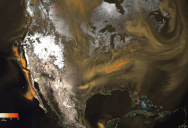NASA Releases New Model Visualizing The Source And Movement Of CO2 Emissions Into The Atmosphere

One of the biggest contributors to climate change is the production of CO2 emissions from humans.
Not surprisingly, countries like the United States and China contribute far more CO2 than other countries, due largely to the heavy power consumption.
While just about everyone knows that activities like driving cars, generating power with dirty fuels, flying planes, operating heavy machinery, burning fires, and other similar activities create CO2, it isn’t very easy to understand exactly how much of a problem it might be.
To help with this, NASA has recently created a visualization that gives far more detail than was possible before.
They used a supercomputer-powered model known as the Goddard Earth Observing System (GEOS) to create it.

The system looks like a weather model, but rather than showing clouds, for example, it will show CO2.
The information gathered when creating this model provide more detail than was previously possible, so people can see where the CO2 pollution is actually coming from.
Lesley Ott from NASA’s Goddard Space Flight center, commented on why this is important, saying:
“As policymakers and as scientists, we’re trying to account for where carbon comes from and how that impacts the planet. You see here how everything is interconnected by these different weather patterns.”
When looking at the visualization, it is possible to zoom in to see the source of CO2 emissions, such as a coal burning power plant.
You can also zoom out and watch the CO2 that is generated moving around the atmosphere.
Ott commented on this:
“Just seeing how persistent the plumes were and the interaction of the plumes with weather systems, it was tremendous.”
You can view an animation from the model below, or look at the full project at NASA.
Hopefully, this detailed model will help inspire people to work harder to protect the environment.
But nothing has moved the needle much thus far.
If you thought that was interesting, you might like to read about a second giant hole has opened up on the sun’s surface. Here’s what it means.

Sign up to get our BEST stories of the week straight to your inbox.




